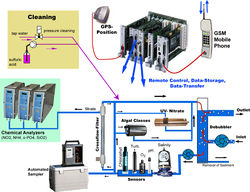Ships of opportunity and ferries as instrument carriers

|
Introduction
Operational monitoring of coastal areas and shelf seas is mainly carried out by manual sampling and analysis during ship cruises. In addition, automatic operating measuring systems on buoys allow routine measurement of standard oceanographic parameters (temperature, salinity, currents) and in some cases other parameters, e.g., turbidity, oxygen and chlorophyll fluorescence. These systems are much affected by biofouling and the maintenance/operation costs are quite high mainly due to ship costs.
Based on all these problems and limitations, it seems logical to investigate which role ships of opportunity could play (Fleming et al. 2002). There are many routes for ferryboats and "ships-of-opportunity" which run quite frequently. Already 60 years ago the "Continuous Plankton Recorder (CPR)" [Reid et al. 1998] followed the idea of using scientific equipment on such ships for continuous recording of environmental data. This method is now improved and shows an impressive data set of semi-quantitative phytoplankton data over the world oceans.
Applying such measuring systems on ferry boats or ships-of-opportunity has several advantages:
- the system is protected against harsh environment, e.g. waves & currents,
- bio-fouling can be more easily prevented (inline sensors),
- no energy restrictions (in contrast to buoys),
- easier maintenance when ferry comes back "to our doorstep"
- lower running costs since the operation costs of the ship do not need to be calculated
- instead of point measurements (buoys) transects yield much more information.
Technical Description
The FerryBox on board of a ship of opportunity consists of a water loop that gets its water from the outside, a data management system for control, data acquisition and storage and a telemetry unit for transmitting the data to shore.
The figure 1 shows a schematic drawing of the German FerryBox system. Water is pumped into the ship from an inlet in front of the ships cooling system. A debubbling unit removes air bubbles, which may enter the system during heavy seas. At the same time coarse sand particles which may be introduced in shallow harbours and which settle and tend to block the tubes are removed as well. Coupled to the debubbler is an internal water loop in which the seawater is circulated with a constant velocity of about 1 m/s. This already decreases the tendency for building bacterial slimes on sensors and tube surfaces. A small part of the water is filtered by a hollow-fibre cross-flow filter module for automatic nutrient analysis (this type of filter keeps the walls of the small hollow-fibres free of suspended seiments of bacterial films by applying high flow velocities, therefore avoiding bacterial contamination that could change the measured nutrient concentrations by microbial processes, e.g., nitrification, re-mineralisation). For a reliable unmanned operation the system is supervised by an industrial programmable logic control which can shut-off the system in case of very severe errors and operates automatic cleaning cycles, e.g., in harbour. Biofouling is prevented by cleaning of the sensors with tap water and rinsing with acidified water. Sometimes clogging of the water inlet in the ship interface causes problems by debris or fish. Since all flow rates are supervised by the system in such cases an automatic pressure back-flushing cycle is initiated which clears the inlet.
See also
Internal Links
External Links
Please note that others may also have edited the contents of this article.
|
Please note that others may also have edited the contents of this article.
|
